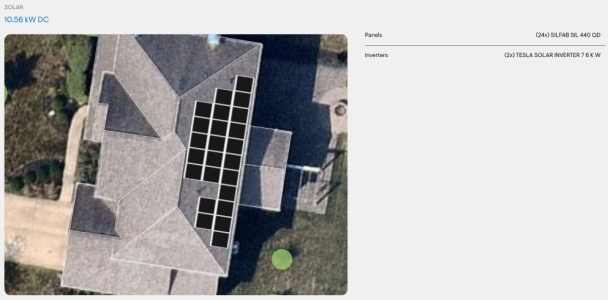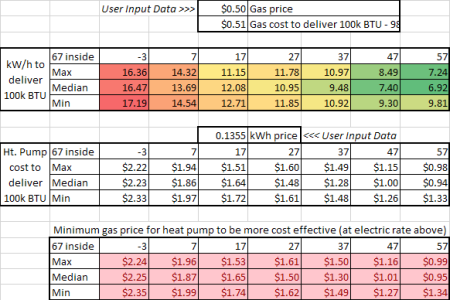Q: How large is your array in KW for $26K?
I paid right around $4.16-4.22/watt for my two setups in 2023 (home and rental). That was excessive when a good deal would ahve been more like sub $3/watt but it was necessary because there was a hard deadline in CA to qualify for NEM2.0 (retail pmt for excess power) and this was an installer that could get the paperwork done in time.
$27K for 6.4KW (16 panels) = pitched roof
$30K for 7.2KW (18 panels) = flat roof
As far as summer/winter generation difference (both arrays point straight south):
- Production on the 7.2KW array is about 1.2-1.38MWh during the summer months and 500-640MWh during the winters here in SF. These panels have no shading b/c they are higher up
- Production on the 6.4KW array is about 1-1.17MWh in the summer and 400-500MWh in the winter.
Therefore, I see about 50% net production in the winter vs summer.
---
Now that you have (or will soon have) solar, you might also want to consider what else you can take advantage of before all the tax credits go away
1) Window efficiency improvements
2) Heatpump water heater
3) Heatpump HVAC
Electricity wise, the single best thing I did with my home was swap from a gas to heatpump water heater. In addition to getting all sorts of tax credits and rebates from the utility, the heatpump water heater dropped my gas consumption by ~40%/mo (we don't need very much heat in SF). The trickiest part of going with a HPWH was a) the necessity of adding a drain for the condensation and b) the necessity of adding 220V power to feed the heatpump. I've read now that there are 120V HPWHs on the market now so that would be even easier. To get the most efficiency out of my unit, I also added a mixing valve after the HPWH so I just heat the water in-tank to 150F and then mix it with cold water (mechanical valve) to a more usable 130F. HPWH draws 400W when running (80KWH/mo for 3ppl).
My next car is very likely to be an EV, if not a PHEV.
-g
Lot of stuff I've thought about in here.
The array as quoted is 10.56 kW - 24x 440W panels, and the pre-incentive price is $25,749. They also quoted $22,977 for a 9.84 kW system using older 410W panels they had an excess of, but I opted for the most efficient panels available due to a better long-term ROI as well as a better panel warranty. So that works out to $2.44/W before the 30% tax credit.

We live in an HOA that until recently had bylaws that outright prohibited solar. The state passed a law during the pandemic that made it harder for HOAs to do that, so the bylaws were revised that made it possible for us - as long as all panels are located on the rear roof only. I hadn't originally planned to take the plunge on solar until our life plans changed when we learned that we are to expect a daughter in February. As a result the funds I had saved up for our next international vacation were freed up, then I learned the HOA didn't prohibit solar after all, thought about the tax credit... and here I am.
Our house is west-northwest facing, so the back roof is aligned to about 100° ESE. We have a relatively tall 10/12 pitch 2-storey roof with no nearby tall trees, so it will get direct sunlight from about 1 hour after sunrise until about 4 in the afternoon.
I ran some numbers through NREL's PVWatts calculator to see how much I'd produce with the panels facing ESE (vs the ideal S) and independently came up with almost exactly the same production numbers the installers provided me. It looks like I'll make about 1.05 MWh each year - if the panels were installed facing true south it looks like I'd be making closer to 1.3 MWh. Our south-facing roof area is much smaller than the roof area on the east side of the house though, so it is what it is.

My MIL used the same company I am using but 2 years ago they were installing 400W panels. She showed me her generation on a sunny day a couple weeks ago and the panels she had on the E side and S side of the roof each had generated about 1.9 kWh over the course of a day. If I do the math, I can expect good production.

Looking at winter vs. summer production estimates what I'm seeing is, using peak July production of about 45 kWh/day as 100%, December production drops down to about 13 kWh/day or roughly 30%. Our winters are quite cloudy, and it shows in the production estimates.
Regarding electric appliances, we upgraded our HVAC several years ago - the same year the incentives became available, actually. I had intended to upgrade our old 13 SEER A/C and had been putting money away for it, when we learned the furnace (original to the 2008 construction) was pumping out off-the-meter levels of CO due to cooked secondary burners. So we bit the bullet and upgraded everything with the most efficient models offered for our capacity (120K BTU furnace and 5 ton A/C). We ended up with a 21 SEER A/C and 11 HSPF heat pump along with a 98.5% efficient furnace. Then about two years after that, the original water heater started leaking so I replaced it with what I could get off-the-shelf at a local Home Depot. Before that happened though I was seriously considering a heat pump water heater, but at the time the 120V models weren't great performers, were disproportionally expensive compared to the gas heaters, and none were in stock.

Natural gas vs. electric pricing here has remained pretty stable until recently - most of the time gas is between .45-.65/thm and electricity is about .13-.14/kWh - though electricity has gone up about 30% over the last year or two and is closer to .18/kWh for anyone not rate shopping. Given how cheap gas is, it's never cheaper for me to run the heat pump instead of the furnace. With the solar array going in though, that will probably change things, especially if I generate an excess credit each year which I would could "use up" by running the heat pump more often. I'm waiting to hear if they think they can get more than 24 panels up on the roof. I only foresee us using more electricity in the future, so having the extra capacity installed now won't leave any regrets.
I can adjust the setpoints for when the heat pump runs vs. the furnace, and I have an Excel sheet with the performance efficiency matrix of the heat pump built-in to help me determine what temperature it's more cost efficient for me to run the heat pump or furnace at. I plug in the cost/therm of natural gas, the price/kWh for electric and it spits out the temperatures at which it becomes cheaper for me to use the heat pump.
This is the business end of that sheet which shows the current prices I'm paying and, correspondingly, the fact that it's not better for me to run the heat pump at all with these gas prices. All the same, I usually let the heat pump run when outdoor temps exceed 50 degrees, even though it's more expensive. It just feels a little more comfortable for some reason.









